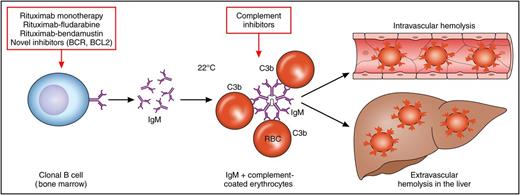In this issue of Blood, Berentsen et al report remarkably high response rates, long-term efficacy, and acceptable toxicity of rituximab with bendamustine in patients with primary cold agglutinin disease (CAD) evaluated in a prospective trial of the Nordic Group.1
Etiology and treatment of primary cold agglutinin disease. Clonal B cells in the bone marrow produce IgMκ antibodies against the I antigen, which bind to erythrocytes (RBC) at low temperatures. This results in coating of erythrocytes with complement C3b and subsequent destruction by intravascular, but predominantly extravascular, hemolysis in the liver. Treatment strategies include (1) direct targeting of the B-cell clone by rituximab or rituximab-containing immunochemotherapy and possibly B-cell receptor (BCR) or BCL2 inhibitors, or (2) interference with complement coating or erythrocyte destruction.
Etiology and treatment of primary cold agglutinin disease. Clonal B cells in the bone marrow produce IgMκ antibodies against the I antigen, which bind to erythrocytes (RBC) at low temperatures. This results in coating of erythrocytes with complement C3b and subsequent destruction by intravascular, but predominantly extravascular, hemolysis in the liver. Treatment strategies include (1) direct targeting of the B-cell clone by rituximab or rituximab-containing immunochemotherapy and possibly B-cell receptor (BCR) or BCL2 inhibitors, or (2) interference with complement coating or erythrocyte destruction.
Primary CAD is a lymphoproliferative B-cell disorder resulting in autoimmune hemolytic anemia after exposure to low temperatures (see figure).2 The antibodies produced are usually immunoglobulin Mκ (IgMκ) and directed against the I carbohydrate antigen on erythrocytes. Even in the absence of histological signs of lymphoproliferation, a clonal B-cell receptor rearrangement provides proof of its clonal origin in almost all patients. Further evidence of the clonality of this disease is the preferential use of certain B-cell receptors (IGHV4-34) and the detection of B-cell–specific mutations.3,4 Binding of the IgM antibodies results in coating of erythrocytes with complement C3b and subsequent destruction by predominantly extravascular hemolysis.
While the disease is sometimes perceived as benign, the majority of patients need blood transfusions, and up to 20% suffer from thrombotic events. Moreover, cold-induced circulatory symptoms and anemia have a negative impact on the quality of life of patients, particularly during the winter months.5,6
There is currently no approved treatment for CAD, and instead of international guidelines based on standardized clinical trials, we have to rely on expert opinions.7
The best available treatment option is the anti–CD20 antibody rituximab. This results in overall response rates of 50% to 60%, but with a time to response of several weeks and a median response duration of only 11 months.8 Given these unsatisfactory results, it seems appropriate to evaluate combination treatments of rituximab with chemotherapy for CAD, since its etiology and survival times are similar to those of an indolent B-cell non-Hodgkin lymphoma (median overall survival ∼10 years). Berentsen and colleagues have previously investigated rituximab and fludarabine.9 Now, the Nordic Group reports on the combination of rituximab with bendamustine given for 4 cycles in 45 patients.1 The overall response rate was 71%, with a remarkably high complete remission rate of 40% and a median duration of response of 32 months. In addition to the resolution of anemia, complete histologic regression of B cell infiltrates was observed in 53% of patients. The overall outcome compared favorably to both rituximab monotherapy and rituximab-fludarabine. Toxicity was higher than with single-agent rituximab, but the rates of neutropenia (33% grade 3/4) and infections (11%) were lower than with rituximab-fludarabine. The data from this prospective multicenter trial are extremely valuable; controlled trials in rare diseases are hard to conduct.
Therefore, rituximab-bendamustine should be regarded as the current best standard for primary CAD as first or subsequent treatment in patients able to tolerate immunochemotherapy in whom the treatment goal is maximal suppression of the causal B-cell clone. However, there are a few remaining issues: (1) efficacy and toxicity must be weighed against each other, taking into account the severity of the CAD and the patient’s fitness; (2) nonchemotherapeutic options, such as the inhibitors ibrutinib, idelalisib, or venetoclax, should still be evaluated in clinical studies; (3) and the late onset of response with all rituximab-based therapies leaves room for rapidly acting treatments, such as complement inhibition.10
Until further studies addressing these issues are conducted, rituximab-bendamustine, as shown by the Nordic Group’s prospective study, should be one of our first choices when treating CAD patients.
Conflict-of-interest disclosure: U.J. has received honoraria from Roche and True North Therapeutics.


This feature is available to Subscribers Only
Sign In or Create an Account Close Modal